Shopping for a defensive handgun can be overwhelming, especially for shooters without much experience. How do you even know what to look for? A common suggestion is to go with a pistol that “feels good in your hands,” but that advice is next to useless when the shooter in question doesn’t know what a gun feels like when it fits correctly. Allowing one’s budget to be the primary guiding factor in selecting a handgun is another frequent mistake, and often results in first-time gun buyers in possession of a poor quality ill-fitting pistol that frustrates their later efforts at learning how to shoot competently. In order to make a good decision, we need some more nuanced criteria to work with.
The video below is not intended as a comprehensive guide to everything you might need to know before buying a handgun for self-defense. In fact, it might leave you with more questions than answers. But my hope is that you’ll walk away with the right questions so that you’ll have a better idea of how to research and make an informed decision.
I’ve provided some general guidelines for choosing a handgun and also suggested a few specific models that cover a variety of handgun types and sizes. Again, it’s not a comprehensive list, but should serve as a good starting point. The transcript of the video can be found below, along with additional comments and links to other articles elaborating on some of the topics mentioned, as well as reviews of several of the handguns suggested.
One of the questions I get asked most often is what handgun I would recommend for self-defense in the home or for concealed carry. Usually this question comes from a prospective first-time gun buyer, or maybe from someone who is trying to help a friend or family member buy their first gun. This is always a difficult question, first of all, because there are no easy one-size-fits-all solutions. The gun has to match the person’s size and physical ability, their lifestyle, and their wardrobe, so there’s a lot to consider. The more challenging part of answering this question is trying to communicate in one short conversation or email the fact that the choice of handgun is really just a small part of being prepared to defend yourself.
So before doing anything else, I typically suggest people read the book “Fighting Smarter” by Tom Givens. I mentioned this one in the video a couple of weeks ago. It’s a pretty thorough introduction to everything you need to know about surviving violent encounters, including how to choose a handgun. And then following that, if you get some training from a qualified self-defense shooting instructor, you’ll have a much better idea of what kind of handgun might work for you.
So that’s my first recommendation: read the book, get some training. If you still want to know what I think, I can give you some general suggestions for what to look for in a defensive handgun and then I’ll offer a few specific recommendations.
What to Look for in a Handgun
1. Reliability
Ken Hackathorn is a phenomenal handgun instructor and one of the pioneers of the private self-defense training industry and I’ve always liked how he described his requirements for a self-defense handgun. The first criteria is reliability. The second is reliability. The third is… reliability. Your gun has to work every time you press the trigger. Each individual gun is a little different, but there are certain models and manufacturers that are more prone to design flaws and quality control problems than others. So choose carefully and do your research.
2. Shootability
The next thing to look for is an attribute we’ll call shootability. What I mean by that is the gun needs to fit you and you need to be able to control it. Shooting ability is a learned skill, but if your finger doesn’t reach the trigger or if the grip is too wide for your hands or if the gun has excessive recoil, you’re going to have a tough time learning the proper shooting technique. I’ve elaborated on this topic in the past, outlining some common pitfalls when looking for a handgun that fits properly.
Generally speaking, the smaller the gun is in overall size, the more difficult it is to control and shoot accurately. The larger the caliber, the harder it is to shoot well. So a full size, medium caliber gun like a 9mm is usually ideal from a standpoint of shootability, but if we’re going to carry the gun, it also has to be comfortable and concealable.
3. Comfort and Concealment
Most people are able to carry a slightly larger gun than they initially think they can. It’s usually a matter of finding the right holster and carry method and then just getting used to it. But every person’s situation is different and if you’re going to carry the gun, you should really carry it all the time. So carry as big a gun as you possibly can, but be realistic and don’t buy a gun that’s so big you know you’re never going to actually even attempt to carry it.
4. Effective Caliber and Capacity
Finally, the gun has to be effective — it has to be capable of reliably stopping a determined violent attacker. That’s mostly going to depend on the person pulling the trigger, but to a lesser extent, effectiveness is a function of the ammunition the gun fires and it’s ammo capacity.
We could argue all day about which caliber is best, but I think for 80-90% of gun owners, a 9mm semi-auto or a .38 special revolver is going to work pretty well. In particular, I suggest Federal HST or Speer Gold Dot ammo for self-defense. There are other good choices, but those are a couple of the more popular loads that have historically worked very well.
As far as ammo capacity, more is better… at least to a point. There are very few situations that would call for a 20 round magazine, but a gun with, let’s say 8 shots can help you solve some problems where a gun with only 5 shots would be inadequate.
So you want a gun that’s chambered in as big a caliber as possible up to 9mm, with as much ammo capacity as possible while still being reliable, shootable, and practical for you to carry.
Defensive Handgun Recommendations
There are probably a lot of guns that would fit all of these criteria for you, and I can’t offer a comprehensive list of all of the possibilities, so I’ll just give you a few of my top recommendations. And I’ll start with some 9mm semi-automatics that could work for both home defense and concealed carry.
Semi-Automatics
1. Sig Sauer P250 Compact and Subcompact 9mm
The Sig P250 compact and subcompact are at the top of the list. They are reliable, affordable, and the design overall is just really user-friendly, especially for less experienced shooters. I think these guns are highly underrated, which means a lot of times you can find a really good deal on them. If you’re able to track one down, the .380 ACP version of the P250 Compact is an ideal handgun for shooters with diminished hand strength, which Tamara Keel wrote about for us in a previous article.
[EDIT: Since this article was published, Sig Sauer has discontinued production of the P250. However, it can still be found on the used market, and aftermarket support is robust thanks to the fact that the P250 shares many parts with the Sig P320).
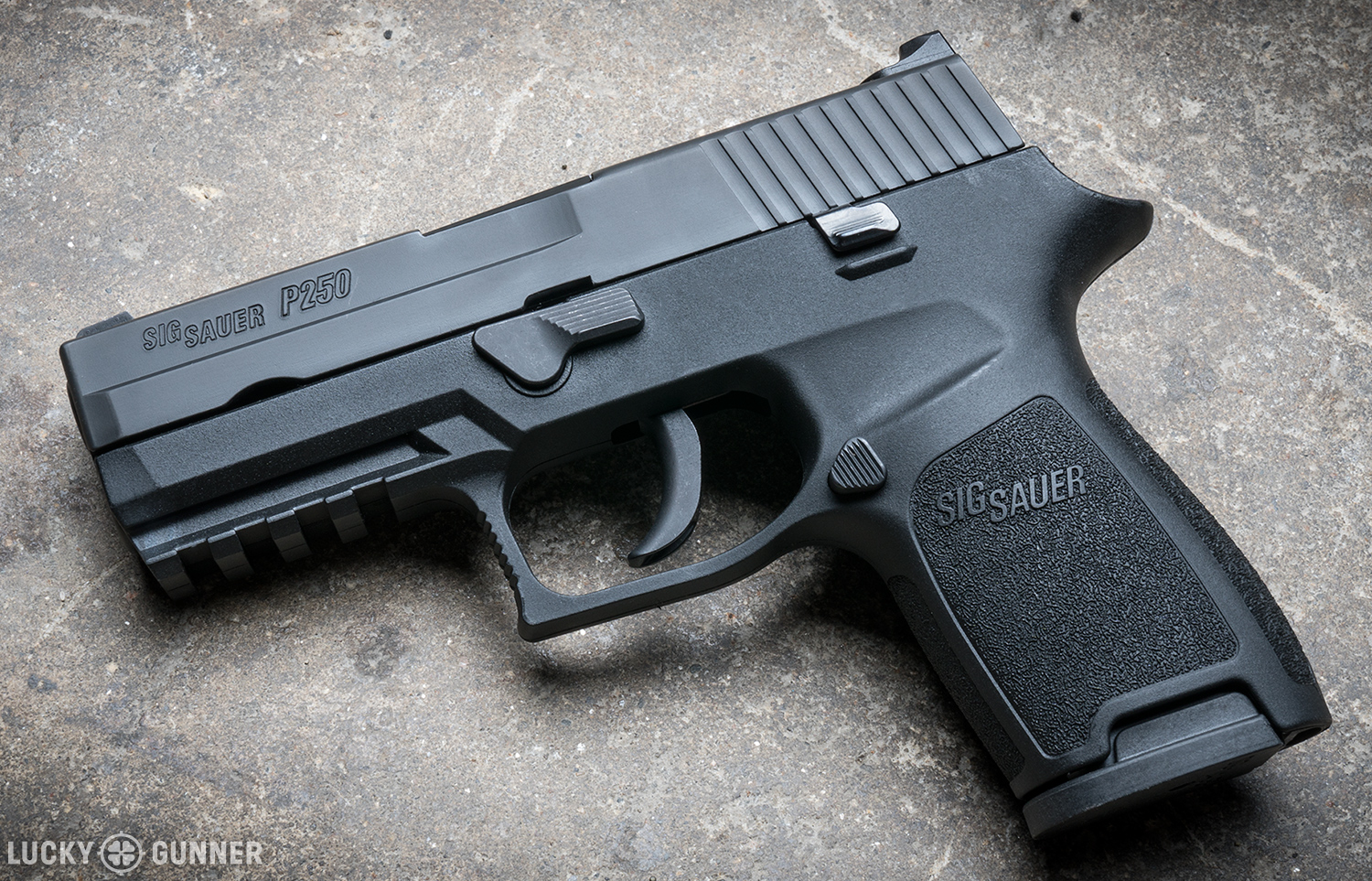
2. Glock 19 and 26
The compact Glock 19 is another good one along with the subcompact Glock 26. I personally don’t care for the ergonomics on these guns, but they’re some of the most popular pistols in the world, and they’re very reliable and there are endless ways to customize them to your liking.
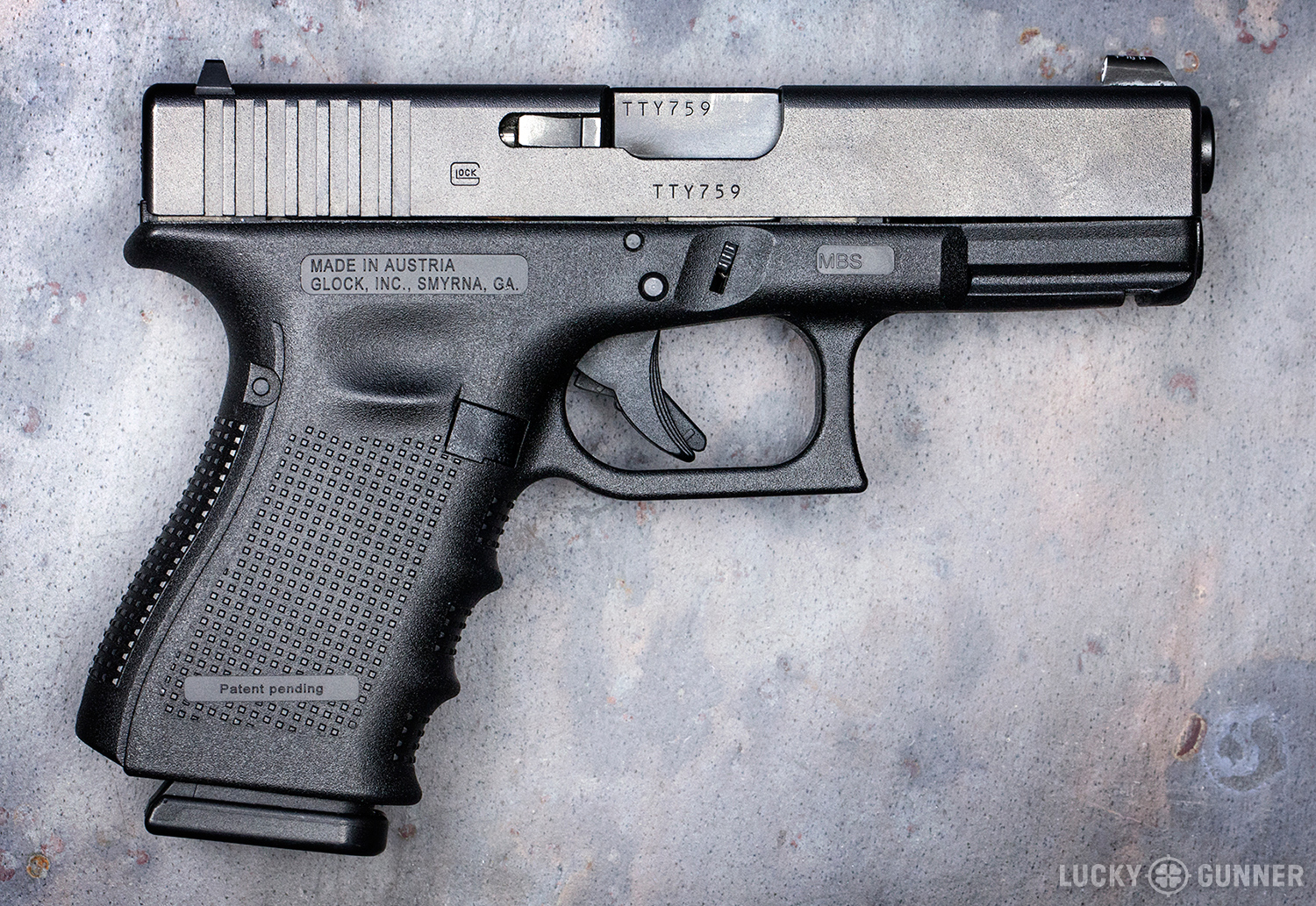
3. Smith & Wesson M&P9 and M&P9c
The Smith & Wesson M&P full size and M&P Compact are similar to the Glocks, but I think they tend to fit people’s hands a little better. I carried and trained with an M&P9c for five years and I think the size is a great compromise between shootability and concealability. All M&Ps are also available with an optional external thumb safety. It’s a well-designed safety that’s easy to use, so if that’s a feature that’s important to you, the M&P is a good option.
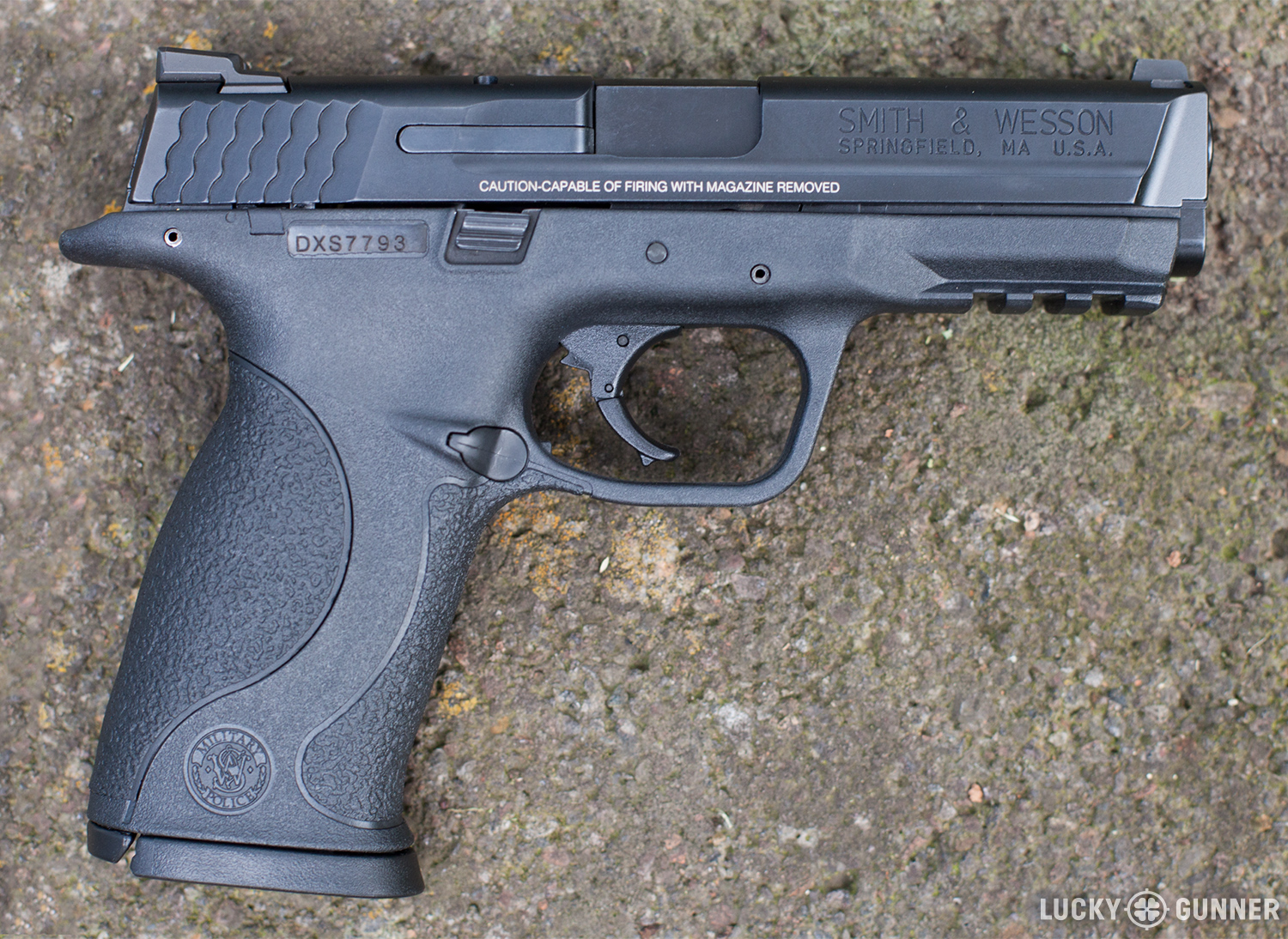
4. Single Stack Options
If all of those seem too big for you to practically carry every day, you might consider a slimmer pistol with a single stack magazine. I like the Smith & Wesson M&P Shield, the Glock 43, and the Walther PPS, all in 9mm. These are going to have snappier recoil and will hold fewer rounds than the other guns I mentioned, but they’re still manageable if you put some work into it.
[EDIT: The Walther PPS M2 is also a great option. Full review here.]
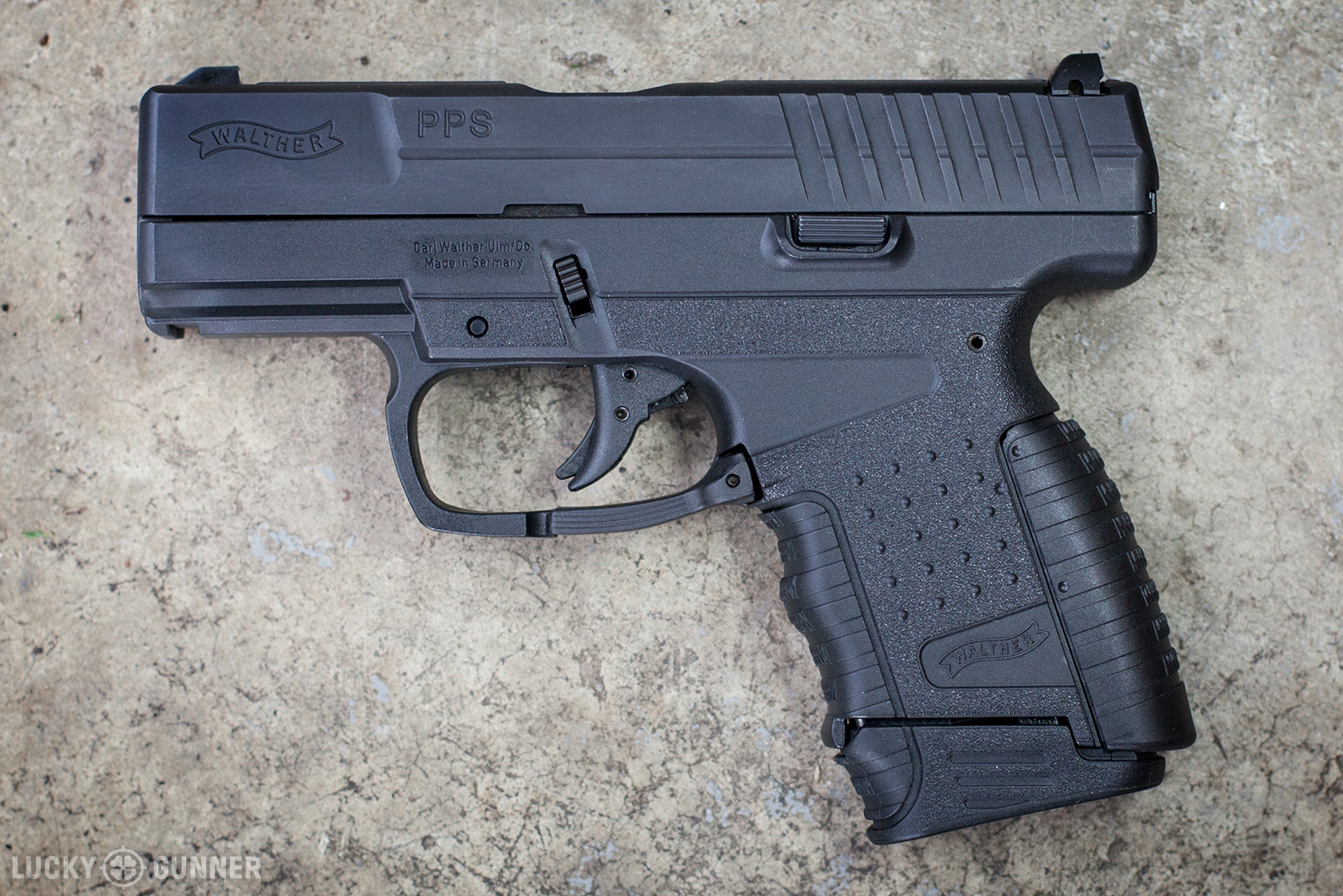
If those still seem to big, you might be tempted to look at the really small pocket-size .380 pistols. I generally don’t recommend these guns if you can avoid them. .380 is just not as effective, and despite the smaller caliber, the micro-pistols are usually hard to shoot, and they are on average far less reliable than other semi-autos. The Glock 42 does seem to work a little better and it’s more shootable than the other small .380s, but it’s also a bit large for what you might call a pocket pistol.
Revolvers
1. Home Defense: Ruger GP100
If you’re interested in a revolver, for home defense I would suggest the Ruger GP100. It’s chambered in .357 magnum, but it can fire .38 special ammo, and that is what you should load it with. Smith & Wesson also makes some nice full size revolvers, but since the year 2000 nearly all of them have been equipped with an internal safety lock mechanism. These locks have been known to occasionally engage themselves while the gun is being fired, and that is a huge compromise of our reliability requirement for a defensive handgun, so I suggest you avoid those. Older Smith revolvers are fine, but any used revolver needs to be thoroughly looked over by a qualified gunsmith before you use it.

2. Concealed Carry: Ruger SP101 and S&W 640 Pro
For a concealed carry revolver, the Ruger SP101 is a good one. It’s heavy and large for a 5 shot gun, but it’s also very shootable and reliable, especially the Wiley Clapp edition that I reviewed last year. The Smith and Wesson 640 Pro is another really shootable but heavy carry revolver (and the subject of another review from my 2015 revolver series). It’s one of the few current production S&W revolvers that does not have the internal lock.
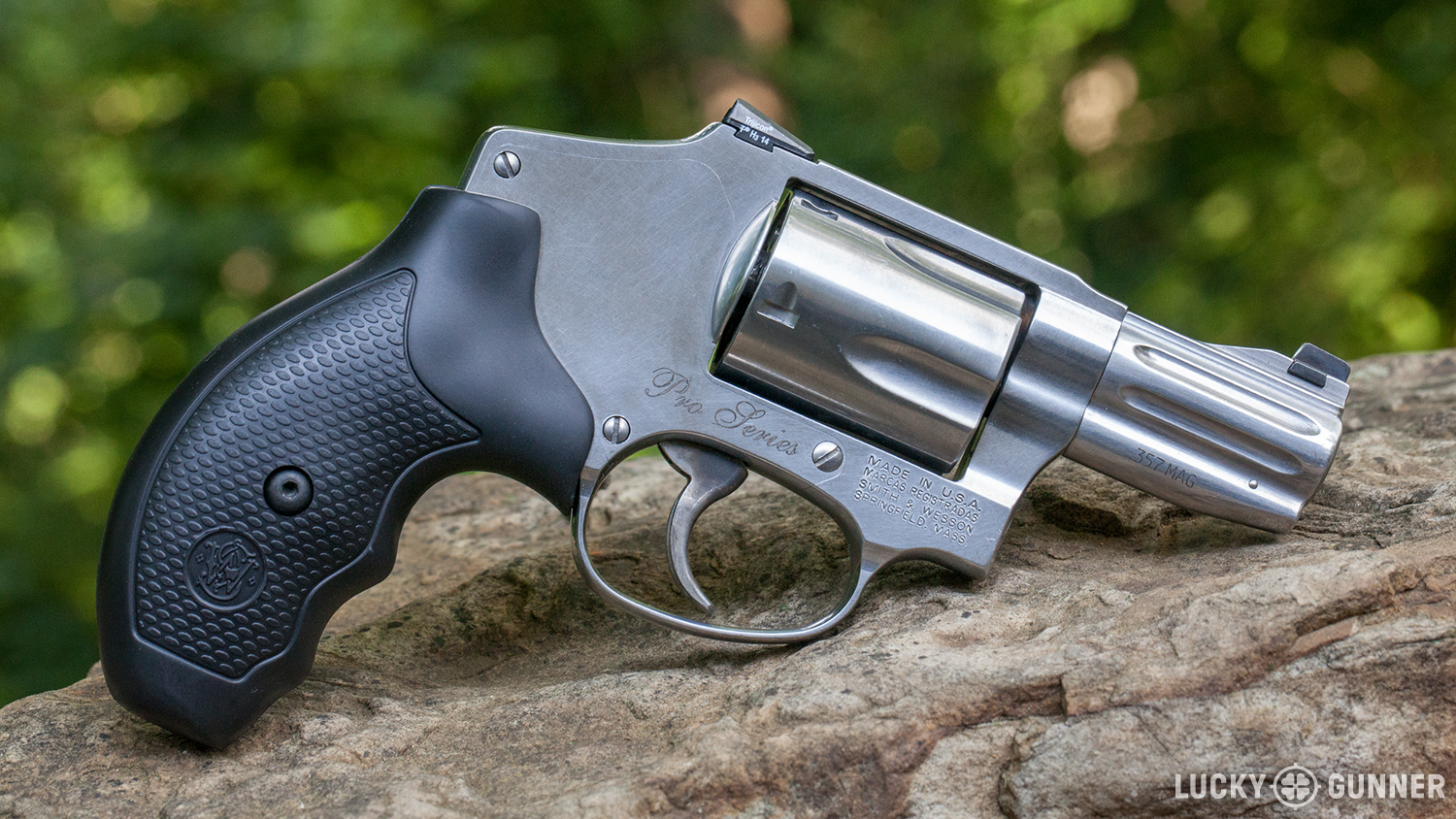
3. Lightweight Concealed Carry: Ruger LCR
A polymer or lightweight alloy-framed revolver can be very challenging to shoot well, especially for an inexperienced shooter. That said, the light weight and snag-free profile makes them among the easiest guns to carry. For this category, take a look at the Ruger LCR. They make it in .38 special and .357 magnum. The .357 version is a few ounces heavier which is going to help out with recoil when you load it with .38 ammo. For either model, I suggest starting out with light recoiling ammo for both practice and self-defense like the lead wadcutters that I talked about last week.
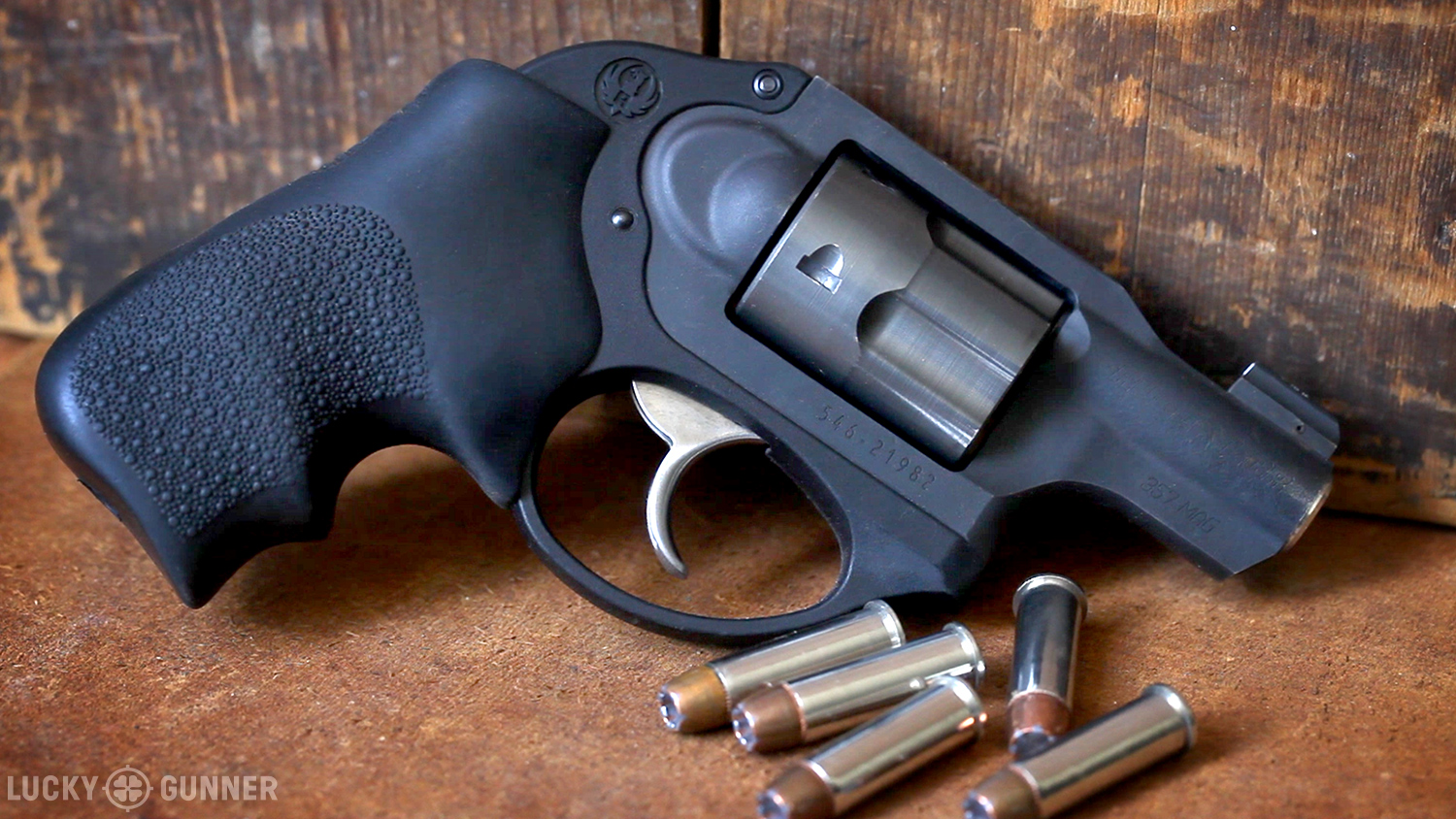
There are plenty of other good options out there, but I think these are some of the most accessible for less experienced shooters. Keep in mind, if you try a handgun and it doesn’t work out for you, you can always sell it and try a different one. So just pick something, get some training, and carry it.
I’m always happy to answer questions when I can, so if you get stuck in your search for a handgun, let me know in the comments and I’ll do my best to help!
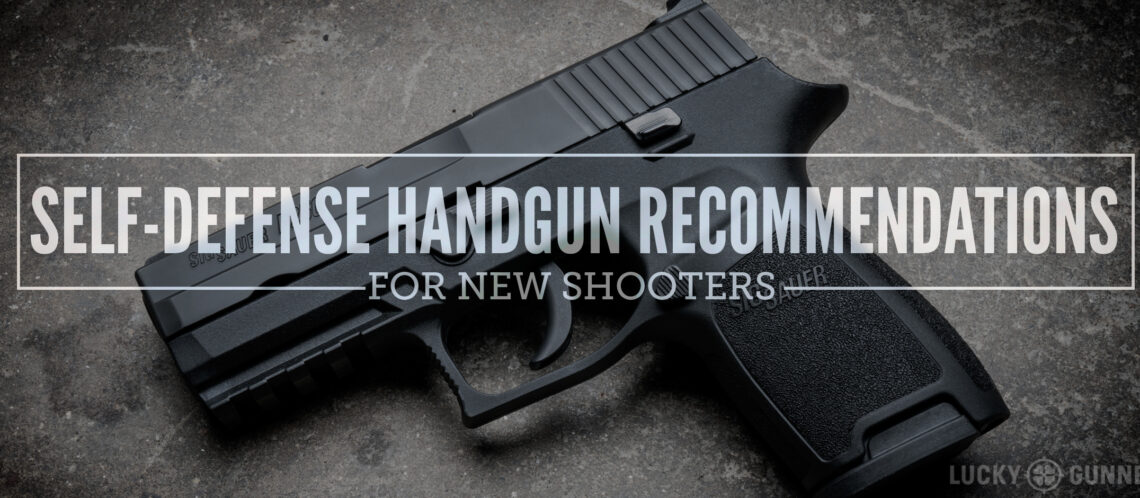

I agree with the point that you can probably conceal a larger handgun than you think. My first handgun was a S&W M&P Shield. It was definitely concealable enough, but its size (and shape) limited my ability to shoot it as well as I shoot other guns. I sold it and got a Sig P320 Compact. The beauty of that gun is if Im worried about concealability I can swap the grip and mag to a subcompact setup (an $80 purchase for a grip and 12rd mag).
Carry and shoot what works best for you. Ignore all the noise from internet ‘experts’ telling you what you must carry and why. Figure it out for yourself and then always carry. Period.
My wife carries a Beretta 92 and I carry a Glock 21. Every day, everywhere we go. Both are accurate and easy to operate, and most of all . . . both are utterly reliable. And neither are compacts, but full sized handguns with good mag capacity and both are easy to shoot well under pressure.
Why would you recommend a P250 over the P320? I have not shot either one but if I were given a choice of a hammer-fired gun over a striker-fired one, I’d choose the striker-fired one. I would assume that the uniformity of trigger pull would be more conducive to accurate shots.
As for home defense revolver, why not a seven or eight round Smith and Wesson revolver? The GP100 is great but its round capacity is too low.
I tried CC’ing the SP101, not very comfortable for my small Asian frame.
The 250 is a DAO so the trigger pull never changes. That said the 320 has a lighter shorter pull. The 320 probably has the best stock trigger of any sticker fired pistol. It even beats out the xd series. That said the 250s are incredibly cheap and he may be one of the people who prefers a more deliberate trigger for inexperienced shooters.
Alrighty, thanks for the correction.
The P250 has a smooth, consistent double action only trigger that breaks at about 6.5 lbs. They should not be a problem for anyone who has been taught how to properly press a trigger. Accomplished shooters will find them slightly slower to run than other action types but still very shootable. The ability to cover the hammer with the strong hand thumb while holstering offers an additional layer of safety not found on the P320. The longer length of trigger travel also provides a hedge against ADs as a result of unconscious “trigger checking” that is common under high stress training and stressful real world encounters. The P320 is great, but I think the P250 is the better choice for non-dedicated shooters who aren’t putting hundreds of rounds downrange every weekend.
As I explained in the article and video, I don’t recommend current production S&W revolvers that are equipped with the internal lock.
I stand corrected. Thank you.
You had mentioned in the article that you used to carry a S&W M&P9C for five years. I’m curious as to why you abandoned it as your carry gun and what your current carry gun preference is?
Most of the time, I’m carrying the Wilson Combat Beretta 92G Compact Carry that I reviewed a few months ago. As for why I switched from the M&P9c, that is thoroughly covered here: http://www.luckygunner.com/lounge/why-switched-double-action/
If you stick with the factory trigger in the M&P and Glock, most of the safety issues I talk about in that video should not be a huge concern. That said, I do think the P250 is a safer pistol to handle and shoot.
Thanks for the quick response. Seems like the 92G Compact Beretta is no longer available.
You may be able to find the Wilson 92G Compact used, but really, the Beretta 92 Compact with Rail in current production by Beretta is a great gun as well, and has been modernized with a rail to fit a light. The 92 is an excellent gun in all of its iterations.
I have been a revolver shooter for decades. However, I’ve started carrying an auto for the increased capacity. I chose the Sig P250sc because it has the most revolver-like trigger of any auto I had tried. It also holds two more rounds than a Glock 26, and, unlike the 26, I can get a full 3-finger grip (I stipple my magazine basepads which helps). Since I carry appendix, being able to put my thumb on the hammer as I re-holster is huge. And yes, I could probably shoot faster with a Glock, but with a smooth DAO trigger, I find that I shoot more accurately. It’s a timing thing, I think. I reset the trigger during recoil, and by the time I’m starting the next trigger press, the sights have settled perfectly on target. With a Glock, I tend rush the shot a bit. I know that training would mitigate this, but I already have 30+ years of training on a long DAO trigger. Why re-invent the wheel?
Rod, agree completely. As I stated in my previous comment, shoot what works best for you and carry it daily. No matter what you choose, there will always be someone telling you you would be better off with some other gun that works good for them.
The problem with “carry what works best for you” is that most beginners don’t have enough experience to know what works best for them, and don’t have the time or the money to rent a bunch of range guns to find out, so you have to give them a starting point. My first choice would be a Glock 19. It’s affordable, parts, magazines, and holsters are ubiquitous, and it is easy to shoot. If that’s not satisfactory, I’d ask why (does the person’s hand size require a single-stack? Is the recoil too much for him/her to handle?) and go from there.
Agreed. It’s not necessarily our the responsibility of experienced shooters to train and guide new shooters, but it sure is a lot of fun. I’ve started a lot of people on shooting and there’s a lot of satisfaction in helping a good person learn to select a gun and learn to shoot it so they can enjoy the sport and defend themselves. But I think that an integral part of that process is helping find what works best for them.
Older Kahr K9 carried daily except at clinic. Beretta .25 easier to conceal there. Like the Sig comments. Will have to take a look. Thanks.
Chris, I couldn’t agree more with your top-of-list recommendation of the Sig P250. I chose this as my carry pistol after getting my LTC earlier this year. It’s accurate, reliable, lightweight, comfortable to shoot, and easy to clean. Unfortunately, your timing is a bit off. Sig has effectively discontinued the P250. Their website now only lists the .22LR version. All through the summer there were rumors about them dropping it from the lineup. Apparently they have gone and done it. What a shame.
I haven’t seen any indication that they’re being discontinued other than the centerfire calibers not being included on the new website design. It would be odd for Sig to introduce the .22LR version in 2016 only to discontinue the rest of the line later the same year. The rumors may be true, but I’ve been hearing those rumors since 2013. I’m really hoping they keep it going… there’s no other hammer-fired true DAO pistol on the market that’s even close to comparable.
Well one thing is for sure – Sig is doing their best to confuse the situation. I live fairly close to the New Hampshire facility. One of our local gunsmiths claims his sources inside the company say the P250 is on the chopping block. Then they go and delete it from the website. I sure hope it isn’t what it looks like. Given its unique status as the most negligent-discharge resistant semi-auto pistol out there, they almost have a duty to keep it available. Three cheers to you (and Tamara) for giving the P250 the praise it deserves in a public forum. If that stimulates demand a little, then maybe it will sway the decision makers at SigSauer.
Any thoughts on Ruger semi’s
none…
Hit or miss. The SR9 series is fairly decent, but I think there are better choices. The LC9 is not quite as reliable as the other single stack 9mm pistols I mentioned.
HI–great article and good discussion. I carry a Glock 26 as my BUG since 1996. But lately I’ve been carrying a LCR .357 mag (carry ammo – 38spl 135gr Gold Dot +P) when I’m out and about. I’m an old head and have been using revolvers for over 30+ years and do not feel under-gunned (always carry three speed strips). I have spent the last two years shooting and carrying a Glock 43 or a M&P Shield 9mm, but recently sent both of them down the road to purchase the LCR .357mag. In the end the single-stacks aren’t much of an improvement over my Glock 26, which foe me, shoots like a larger pistol… 🙂
All of the guns mentioned are good choices and one I would add to the list is the Ruger SR9c. Very concealable with the 10 rnd mag and comes with a 17 rnd as well. Striker fired with external ambi thumb safety. I like the trigger better than any I have fired and you can get it in the low $400 range which is nice because while price is not the only issue for me it is still an issue.
I have an SR9c too. Nice ergonomics, though the “adapter/sleeve” in the 17 round mag was too loose and moved around a bit. And the safety can be a b!tch to disengage.
Chris,
Nice list, all the suggestions are well thought out, and I agree
with it. Curious to the Beretta PX4 not
being on the list. I know cost may be an
issue, but can be had for approx. the same cost if not less than the
Glocks. As always keep up the awesome
work.
I can’t imagine recommendations 2,3 & 4 as being good choices for a beginning handgunner. I know of three separate local incidents where LEO’s have had AD’s where people got shot with service weapons utilizing those little flipper thingy triggers.
I also know of two shooters that use these very pistols for EDC, yet they won’t chamber a round until the need arises. Why I asked, because they don’t trust the trigger safety?!
I know there are those that swear by these, type of triggers, and believe me, some are quite good at swearing. But I have yet to hear a testimony where someone said, “That little flipper thingy, prevented an AD.”
https://youtu.be/SP1ISApICeA